
by successfulbob | bird photography, Lumix GX85, Lumix Lounge, photography, photography creativity, photography gear, wildlife photography
Outdoor Photography – Walking Oak Creek
Getting out into the open air in among the Vortexes of Sedona, Arizona is a great pick me up from being behind the screen of the electronic world in which we spend a fair amount of time as photographers. I chose to spend the afternoon on the banks of Oak Creek near Cathedral Rock and thought I’d share some ideas on the gear I assembled for my trek through the woods.
Since I was out for the afternoon, I took a lot of gear to have many options for various shooting situations. Included in that day’s kit were three cameras, five lenses and two tripods. The reason I was able to pack so many alternatives is that of the light weight of Pansonic’s micro 4/3rds camera system. I’ll share a video on the gear and my day over the next couple days but for now, read on about the first camera. Subsequent cameras and their use will follow.
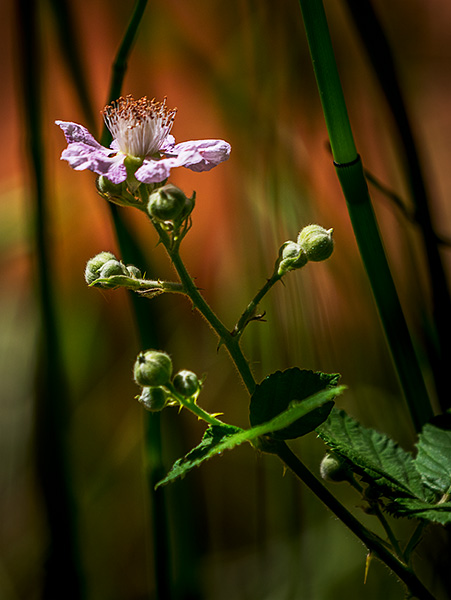 This flower is about the size of my thumbnail. The 100-400mm lens almost works as a macro lens isolating details against a soft background. It’s all about the light.
This flower is about the size of my thumbnail. The 100-400mm lens almost works as a macro lens isolating details against a soft background. It’s all about the light.
Lumix GX85 with the Leica 100-400mm lens – Fast becoming one of my favorite combinations for wildlife and art photography. One of the reasons is the five-axis image stabilization plus two. This combination allows for an extra five stops of handhold-ability, negating the need for a tripod in almost any situation that does not involve multiple exposures for the creation of a single image. Weight 4 pounds.
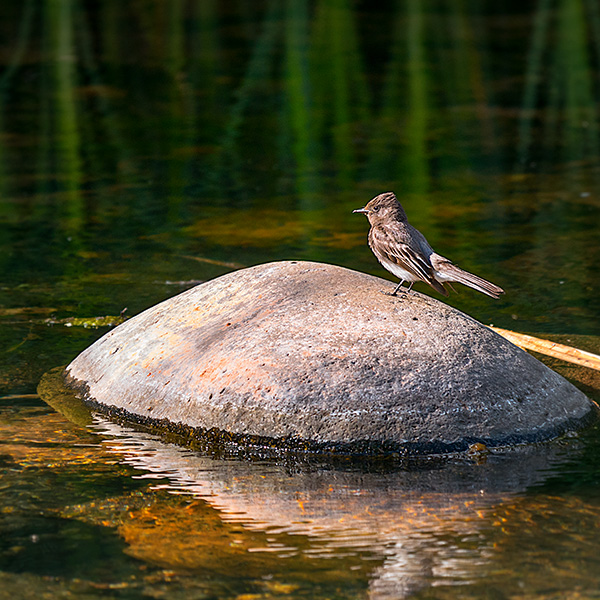 Of course, reaching across the creek for small wildlife and getting plenty of detail is evident. The 100-400mm lens is the equivalent of a 200-800mm and with the stabilization makes for sharp images.
Of course, reaching across the creek for small wildlife and getting plenty of detail is evident. The 100-400mm lens is the equivalent of a 200-800mm and with the stabilization makes for sharp images.
Another feature that helps in obtaining sharp images is the removal of the anti-alias filter. The filter was placed in front of sensors in the past to help prevent moire patterns. That is now being handled by the processing engine. The filter blurred detail. The noise patterns showed the adverse effects of this filter. Now I’m getting a film grain-like noise which is allowing me to push up ISO if necessary with no ill effects.
 I generally don’t bisect an image, but I stitched two images together to complete the scene. When I go to use this, I can crop to make the images more about the pond or more about the falling water.
I generally don’t bisect an image, but I stitched two images together to complete the scene. When I go to use this, I can crop to make the images more about the pond or more about the falling water.
These were just a few images from this camera/lens combo. Next post I’ll share why I bring the Lumix GX8 and 20mm 1.7 lens. (along with a couple of others)
Yours in creative Photography, Bob
Save
Save
Save

by successfulbob | landscape photography, LumixGH5, wildlife photography
Sedona Wetlands – Part Two
The other day I shared some traditional images from the beautiful Sedona Wetlands off of Highway 89A on the right if you are heading to Cottonwood. Here’s some more info from the previous post.
In addition to the straight images, I like to try something just a little more creative. It can be fun to push the images to an artier level. I guess that’s a word because my Grammer checker gave me the word when I tried more arty in the sentence.
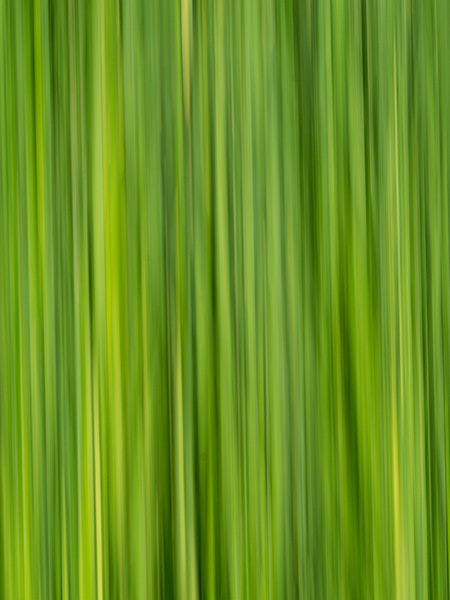 Here are some wetlands grasses that are transformed into blended shapes and colors by moving the camera up while making the exposure.
Here are some wetlands grasses that are transformed into blended shapes and colors by moving the camera up while making the exposure.
Very different effects can be created by changing the shutter speed or the speed of movement of the camera. Experiment until you get the image for which you are looking. There can be many pleasant surprises along the way.
 Here’s an example of an even slower shutter speed than the image at the top of the post which allows the colors to blend into an even more abstract look.
Here’s an example of an even slower shutter speed than the image at the top of the post which allows the colors to blend into an even more abstract look.
 I get a very peaceful, easy feeling (Que Eagles song) when I look at this simplified composition of some new grasses poking their heads through the water.
I get a very peaceful, easy feeling (Que Eagles song) when I look at this simplified composition of some new grasses poking their heads through the water.
All images were made with the Lumix GH5 and the 100-400mm f4.0-6.3 Leica DG Vario-Elmar lens. This camera lens combo is one I am enjoying for any shooting situation that allows for a bit of distance between the subject and myself.
Yours in Creative Photography, Bob
Save
Save
Save

by successfulbob | bird photography, LumixGH5, photography, photography creativity, wildlife photography
Sedona Wetlands
Difficult to believe that there are wetlands in the high desert of Sedona. But, there are! And it’s becoming one of my favorite places to test out new cameras and lens combinations.
The Sedona Wetlands Preserve is approximately 27 acres in Effluent Management Area 2, located south of the Sedona Waste Water Reclamation Plant. The wetlands have six basins, with a total water surface area of approximately 12.2 acres or 9.6 million gallons. They basins are set up to have different depths of water from very shallow up to four feet which make for excellent habitat for a variety of critters. There are some thoughts for making sure all who go enjoy the experience, including the wildlife I pulled from the wetlands website.
Wildlife Viewing Etiquette
• Our viewing behavior can also harm the animals we are looking for unless we take special care.
• Please keep these considerations in mind.
• Observe from a distance, so the wildlife being watched are least disturbed.
• Never chase wildlife or pick up their young even if the parents are not visible.
• Leave feathers, eggshells, nests and even dead animals where you find them.
• Respect other viewers to avoid intruding on another person’s enjoyment.
• Limit the time you spend closely viewing any animal
I took the Lumix GH5 for a spin with the Leica DG Vario-Elmarit 100-400mm lens yesterday afternoon when I had a few minutes to work (er’ play) trying out the stabilization and handhold-ability with this combo. Remember, due to the Micro 4/3rds chip, I’m holding an 800mm equivalent lens and very comfortable with the resulting images.
 This image is a severely cropped image of a Ruddy Duck which can be printed to about 18 inches square.
This image is a severely cropped image of a Ruddy Duck which can be printed to about 18 inches square.
(see full size below)
 Full-size capture of the Ruddy Duck at the Sedona Wetlands
Full-size capture of the Ruddy Duck at the Sedona Wetlands
 These flowers are quite small. Using the 100-400mm lens extended all the way gives an almost macro feel to the photo. The blooms are about the size of my thumbnail.
These flowers are quite small. Using the 100-400mm lens extended all the way gives an almost macro feel to the photo. The blooms are about the size of my thumbnail.
 A tiny flower puff around the scale of a fingernail. It is kind of a life amongst past life with the fading buds.
A tiny flower puff around the scale of a fingernail. It is kind of a life amongst past life with the fading buds.
In a day or so I’ll share some more images with a bit more of an artistic flair to them. This camera and lens combination is extremely versatile.
Yours in creative Photography, Bob
Save

by successfulbob | bird photography, black & white, imaging competition, inspiration, Lumix GX8, Lumix Lounge, photography competition, photography creativity, photography gear, wildlife photography
Sunday Photo Art Quote – Thomas Jefferson
I’ve seen this quote attributed to Tom although I’m certain it belongs to him as there are variations in place attributed to others. I try to research my quotes for accuracy. With that in mind if you know who the originator of this quote was, please let me know.
 “I am a great believer in luck, and I find the harder I work, the more I have of it.” – Thomas Jefferson
“I am a great believer in luck, and I find the harder I work, the more I have of it.” – Thomas Jefferson
You might ask, “What in the heck does this have to do with art, Bob?”
It all has to do with getting in there and doing the work. Whether you feel like doing it or not. Many times I will happen into a fortunate art situation just because I keep on trying even though things have not worked out crazy good in the past. If you see a concept, you need to keep acting on it until it comes to fruition.
Here’s an example. I love photographing wildlife, especially birds. I enjoy the texture of their wings. Studying and anticipating their movements to capture more compelling images. The time alone searching out new behaviors. It can be very frustrating to try to come up with something original. That doesn’t stop me from going out and trying. Over and over. And over. Until that magic moment when the luck part comes into play. Because I was still there trying I was treated to this perfect moment of a Snowy Egret chasing fish.
I captured approximately 200 images of the bird working the shallows in front of me. And this is the composite I thought I wanted to accomplish.
 Working composite of Dance of the Snowy Egret
Working composite of Dance of the Snowy Egret
I had sifted through and extracted many images of the snowy egret to get this far but wasn’t happy with what was happening. It was the vision I originally had in my head while I was photographing the bird, but it just wasn’t working form, although my wife loved it. So I kept working.
So I kept working. And working.
And because I kept working on it even though I wasn’t happy I had another stroke of luck. In turning off the background to clean up my extractions of the birds, I saw the image in it’s simplest form. All attention became focused on the positions of the birds with absolutely no distractions.
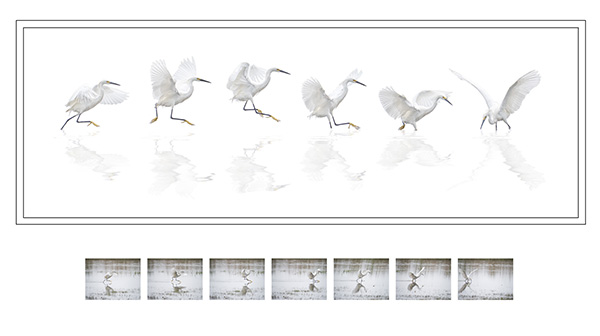 PPA Loan Collection Image – Dance of the Snowy Egret by yours truly
PPA Loan Collection Image – Dance of the Snowy Egret by yours truly
I entered the image in the International Photographic Competition from Professional Photographers of America, and it was judged into the Loan Collection in the Master Artist category. That judging is based on twelve elements (click here for more on the twelve) including composition, technical excellence, and storytelling. Also, how the artwork was accomplished is a significant part of the criteria which is why the reference images are shown.
I feel I was lucky on two fronts in the creation of this photo. But I did work hard to get ultimately get there
But I did work hard to get ultimately get there.
Yours in Creative Photography, Bob
PS – I think one additional piece of luck was the equipment I’ve been using. Because the micro 4/3rds format is so small and light I was able to handhold a 600mm equivalent lens and track the egret comfortably for a long period of time. Heavier gear would have required a tripod and been much less mobile. Lumix GX8 with the 100-300mm f4.0-5.6 lens

by successfulbob | bird photography, landscape photography, Lumix GX85, Lumix Lounge, photography, photography creativity, wildlife photography
Bosque del Apache Wildlife Refuge Part Five
This post is the final in this series from a very productive shoot at the wildlife refuge in New Mexico. The refuge is a very target rich environment for making bird images. The scenery wasn’t bad either! Let’s talk about creativity just a bit more. I saw a lot of photographers while I was there. And except for gear difference such as long lenses, I believe most photographers there were getting pretty much the same photo.
Why would I say that? Check out the photo below of the scene at almost every location in the refuge. What do you see?
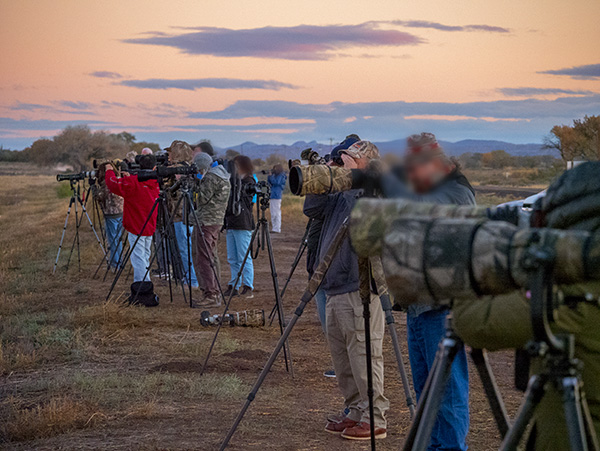 Take a careful look. Every camera is at the photographer’s eye level.
Take a careful look. Every camera is at the photographer’s eye level.
I saw this ALL the time. To obtain a different look to your images, you need to look at things from a different viewpoint. I spent a fair amount of time on my knees, sitting on my butt and getting the camera off of the tripod. Look back through my past posts, and I think you’ll see lots of variety. Bosque Pt 1 Bosque Pt 2Bosque Pt 3 Bosque Pt 4 Changing the height that you shoot from can have a dramatic effect on what is in the background of your subject.
I also heard a lot of motor drives at 8-15 frames per second going off. Motor drives can be helpful when tracking moving subjects or quickly changing background and lighting conditions, but I would see that happening when a photographer was shooting a relatively stable subject in constant light. Save yourself from extra editing time on the computer, Turn off the motor drive when you don’t need it.
 Taking a lower angle allowed for the reflection with the grassland environment in the background.
Taking a lower angle allowed for the reflection with the grassland environment in the background.
 Had to be on my knees to get the composition of the reflection where I wanted it placed.
Had to be on my knees to get the composition of the reflection where I wanted it placed.
 Generally, a gimbaled tripod head would be needed to capture solid images of birds in flight. With new gear and in-camera stabilization improvements, more creativity is possible. The Sandhill Crane images were captured handheld with the Lumix GX85 and the Lumix 100-400mm lens (200-800 35mm equivalent) lens fully extended.
Generally, a gimbaled tripod head would be needed to capture solid images of birds in flight. With new gear and in-camera stabilization improvements, more creativity is possible. The Sandhill Crane images were captured handheld with the Lumix GX85 and the Lumix 100-400mm lens (200-800 35mm equivalent) lens fully extended.
Excited about possibilities as I push this camera and lens combo even further.
See what you can do to differentiate your images from others at every chance you get.
Yours in Creative Photography, Bob
Save
Save

by successfulbob | bird photography, fine art photography, Lumix GX85, Lumix Lounge, wildlife photography
Bosque del Apache Wildlife Refuge – Part Four
Getting Artsy
When photographing a specific subject or area I always shoot for good solid captures at the beginning. After I know I’ve got some good work ‘in the can’, I see what I can do to push the creative ‘Artsy’ side. Here are some of those images.
Let’s look at some tracking flight images with the shutter speed set to a slow speed in this case most were at 1/250th sec. Images were captured handheld with the Lumix GX85 and the Lumix 100-400mm lens (200-800 35mm equivalent) Most were with the lens fully extended.
 Sandhill cranes photographed at takeoff panning with slow shutter speed.
Sandhill cranes photographed at takeoff panning with slow shutter speed.
 This technique adds lots of movement and an abstract feel to the images.
This technique adds lots of movement and an abstract feel to the images.
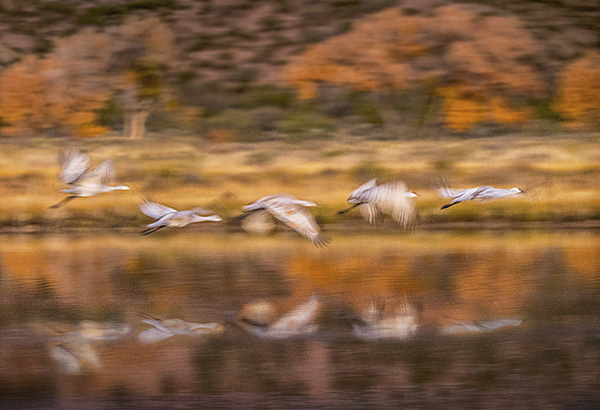 Further into the art arena using additional post-processing techniques. MacPhun software Focus CK was used to bring more attention to the flight of the cranes.
Further into the art arena using additional post-processing techniques. MacPhun software Focus CK was used to bring more attention to the flight of the cranes.
 Cropped SOOC (straight out of camera) 1/40th SEC shutter speed.
Cropped SOOC (straight out of camera) 1/40th SEC shutter speed.
 Image from above worked with additional post processing.
Image from above worked with additional post processing.
 Canada Geese on a flyby 1/1600th SEC shutter speed.
Canada Geese on a flyby 1/1600th SEC shutter speed.
Experiment. Push. Play. Don’t be afraid to get an imperfect result in camera. Playing can lead to more interesting and personal image creations.
Let me know what you like, or don’t care for, in these images. I have an inquiring mind!
Yours in Creative Photography, Bob
Save
Save

 This flower is about the size of my thumbnail. The 100-400mm lens almost works as a macro lens isolating details against a soft background. It’s all about the light.
This flower is about the size of my thumbnail. The 100-400mm lens almost works as a macro lens isolating details against a soft background. It’s all about the light. Of course, reaching across the creek for small wildlife and getting plenty of detail is evident. The 100-400mm lens is the equivalent of a 200-800mm and with the stabilization makes for sharp images.
Of course, reaching across the creek for small wildlife and getting plenty of detail is evident. The 100-400mm lens is the equivalent of a 200-800mm and with the stabilization makes for sharp images. I generally don’t bisect an image, but I stitched two images together to complete the scene. When I go to use this, I can crop to make the images more about the pond or more about the falling water.
I generally don’t bisect an image, but I stitched two images together to complete the scene. When I go to use this, I can crop to make the images more about the pond or more about the falling water.




























